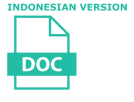Afiks Bahasa Korea dalam Esai Jichyeotgeonna Joahaneun Ge Eopgeona
Adinda Hasna Rahmadia(1), Usmi Usmi(2*)
(1) Universitas Indonesia
(2) Universitas Indonesia
(*) Corresponding Author
Abstract
This study aims to analyze Korean language affixes. The source data in this research was taken from a Korean essay entitled Jichyeotgeona Joahaneun Ge Eopgeona. This study was designed to answer the following research question; how is the classification of affixes contained in the essay Jichyeotgeona Joahaneun Ge Eopgeona based on the theory of affix classification proposed by Kim et al. (2005). This study used mixed methods with descriptive-analytical approach. Based on the results of data analysis, there were found 28 affixes, consisting of 4 prefixes and 24 suffixes in the data source. From the 4 prefixes, it is found that 3 prefixes are attached to the basic form of noun class and 1 prefix is attached to the base form of verb or adjective class. Furthermore, from 24 suffixes, 6 suffixes form verbs, 15 suffixes form nouns, 2 suffixes form adjectives and 1 suffix forms adverbs. Through the results of this study, it is hoped that it will provide readers with additional knowledge and reference materials regarding affixes in Korean.
Keywords
Full Text:
PDFReferences
Bagiya, B. (2017). Infleksi dan Derivasi dalam Bahasa Indonesia. Journal of Language Learning and Research, 1(1), 32–40. https://doi.org/10.22236/jollar.v1i1.1240
Banjarnahor, A. S. (2017). Afiks-Afiks Derivasi Bahasa Inggris Dan Bahasa Batak Toba (Suatu Analisis Kontrastif). Jurnal Elektronik Fakultas Sastra Universitas Sam Ratulangi, 1(4). https://ejournal.unsrat.ac.id/index.php/jefs/article/view/16873
Chaer, A. (2012). Linguistik Umum: Edisi Revisi. Rineke Cipta.
Devita, A. A., & Sofyan, A. N. (2020). Afiks Derivatif Pada Lagu Ed Sheeran Dalam Album Divide: Suatu Kajian Morfologis. Medan Makna: Jurnal Ilmu Kebahasaan Dan Kesastraan, 18(1), 1–13. https://doi.org/10.26499/mm.v18i1.2307
Geul, B. W. (2019). Jichyeotgeona Joahaneun Ge Eopgeona. Ganghanbyeol.
Gu, B. K., Park, J. Y., Lee, S. W., Lee, J. H., Hwang, S. Y. (2015). Hangugeo Munbeop Chongron 1. Jipmoon
Kim, J. S., Park, D. H., Lee, B. G., Lee, H. Y., J., J. H., Choi, J. S., & Heo, Y. (2005). Oegugineul Wihan Hangugeo Munbeop 1. Communication Books.
Lee, I. S. (2004). Hanguko Munbop. Taehaksa Press.
Lim, J. R., Lee, E. G., Kim, J. R., Song, C. S., Hwang, M. H., Lee, M. G., & Choi, W. H. (2005). Hakyo Munbopgwa Munbop Gyoyuk. Bakijung.
Masfufah, N. (2014). Afiksasi dalam Bahasa Indonesia Ragam Gaul di Kota Samarinda. LOA: Jurnal Ketatabahasaan Dan Kesusastraan, 9(1), 77–85. https://ojs.badanbahasa.kemdikbud.go.id/jurnal/index.php/loa/article/view/2067
Nazir, M. (1998). Metode Penelitian. Ghalia Indonesia.
Nur, T. (2010). Fungsi Afiks Infleksi Penada Pesona, Jumlah, dan Jender pada Verba Bahasa Arab: Tinjauan dari Perspektif Morfologi Infleksi dan Derivasi. Humaniora, 22(1), 75–85. https://jurnal.ugm.ac.id/jurnal-humaniora/article/view/987
Sugiyono. (2018). Metode Penelitian Kuantitatif, Kualitatif dan Kombinasi (Mixed Methods). Alfabeta.
Wiyatasari, R. (2013). PEMBENTUKAN KATA SECARA DERIVASIONAL DALAM BAHASA JEPANG (Suatu Kajian Morfologi). IZUMI, 2(2), 1–12. https://ejournal.undip.ac.id/index.php/izumi/article/view/6902
Article Metrics
Refbacks
- There are currently no refbacks.
Copyright (c) 2021 The Author(s)

This work is licensed under a Creative Commons Attribution-ShareAlike 4.0 International License.







